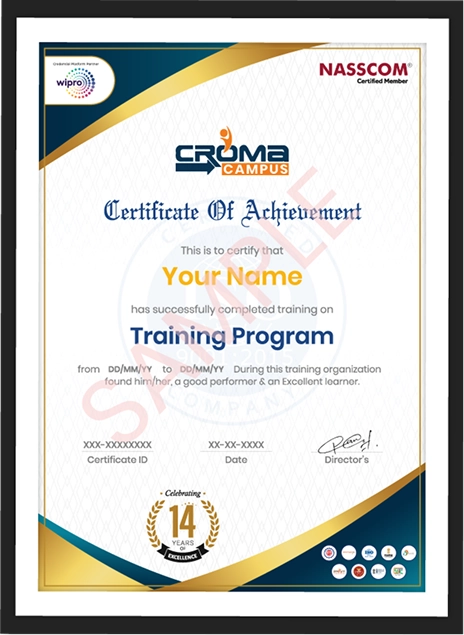Course Design By
Nasscom & Wipro
Software testing, the SDLC, the waterfall approach, traditional testing, Black Box Testing, and White Box Testing will all be covered.
To get practical knowledge of unit testing, you will work on real-world projects and industrial scenarios.
Learn how to collect data for tests, track issues, and conduct user acceptance testing.
Join our manual testing programme to learn the skills you'll need to pass the manual testing exam.
Learn how to perform unit testing, regression testing, user acceptability testing, security testing, and other forms of software testing.
Get a high-level overview of software testing goals, approaches, methodologies, and procedures.
Create and carry out test plans.
Perform testing and risk management for multiple configurations.
Defects should be identified and avoided.
Acquire knowledge about the Bugzilla test management tool.
Identify any log flaws.
Acquire a thorough understanding of the various aspects of software development models.
Create functions that are defined by the user.
Create tests that are based on data.
In QTP, you can use VBScript and sophisticated VBScripting.
In India, the typical manual testing wage is 700,000 rupees per year, or $359 per hour.
The starting salary for entry-level roles is $450,000 per year, with most experienced individuals earning up to $1,500,000 per year.
Based on 44 salaries, a mid-career Software Tester with 5-9 years of experience gets an average total salary of 640,610.
Based on 68 salaries, an experienced Software Tester with 10-19 years of experience gets an average total salary of $976,020.
Manual testing is one of the most in-demand skills in the IT sector, and many employers check for it in resumes when hiring.
Professionals in Manual Testing and QTP might find a variety of work possibilities all across the world.
In comparison to other IT specialists, skilled and certified manual testers are paid the most in the market.
Many multinational firms are seeking Manual Testing and QTP experts in a variety of roles.
QA teams can act on instinct and work on elements right away using manual testing.
Users can easily examine the code and experiment with adding an element.
Manual testing is not only less expensive to implement, but it may also deliver faster results than an automated test.
It makes it easier for the testing engineer to debug or locate errors.
Defining testing tasks for subordinates - testers or test engineers.
All test planning responsibilities.
To see if the team has all of the resources it needs to complete the testing tasks.
To see if testing is integrated into the software development process at all stages.
Prepare a report on the status of testing activities.
Interactions with customers are required.
Regularly updating the project manager on the status of testing efforts.
You'll get the opportunity to interview for employment and work in well-known fields.
Google, TCS, IBM, Cognizant Technology, Accenture, and other major design businesses around the world are among the hiring industries.
Our job placement training prepares you to be successful in your new position.
We'll even help you be hired by worldwide organisations and business behemoths by providing 100 percent placement support.
We'll work with you to create the professional profile you've always wanted.
Make a name for yourself as a worldwide sought-after expert.
In interviews, you'll be able to effortlessly outperform other prospects.
In today's tech-dominated market, you can increase your value.
Your credentials have been verified, allowing you to operate remotely.
To become a qualified specialist, select the best manual training course.
we train you to get hired.

By registering here, I agree to Croma Campus Terms & Conditions and Privacy Policy
+ More Lessons
Course Design By

Nasscom & Wipro
Course Offered By

Croma Campus

Stories
success
inspiration


career upgrad


career upgrad


career upgrad


career upgrad
05-Jul-2025*
07-Jul-2025*
09-Jul-2025*
05-Jul-2025*
07-Jul-2025*
09-Jul-2025*

You will get certificate after
completion of program

You will get certificate after
completion of program

You will get certificate after
completion of program
in Collaboration with






Empowering Learning Through Real Experiences and Innovation

we train you to get hired.

Phone (For Voice Call):
+91-971 152 6942WhatsApp (For Call & Chat):
+91-971 152 6942Get a peek through the entire curriculum designed that ensures Placement Guidance
Course Design By


Course Offered By

Ready to streamline Your Process? Submit Your batch request today!
At Croma Campus, we have a dedicated team who will assist you once the course is completed.
We offer a variety of payment methods, such as Net Banking, Cash, Credit Card, UPI, and others.
There are no prerequisites for this course.
At Croma Campus, we have a dedicated team who will assist you once the course is completed.

FOR QUERIES, FEEDBACK OR ASSISTANCE
Best of support with us
For Voice Call
+91-971 152 6942For Whatsapp Call & Chat
+91-9711526942